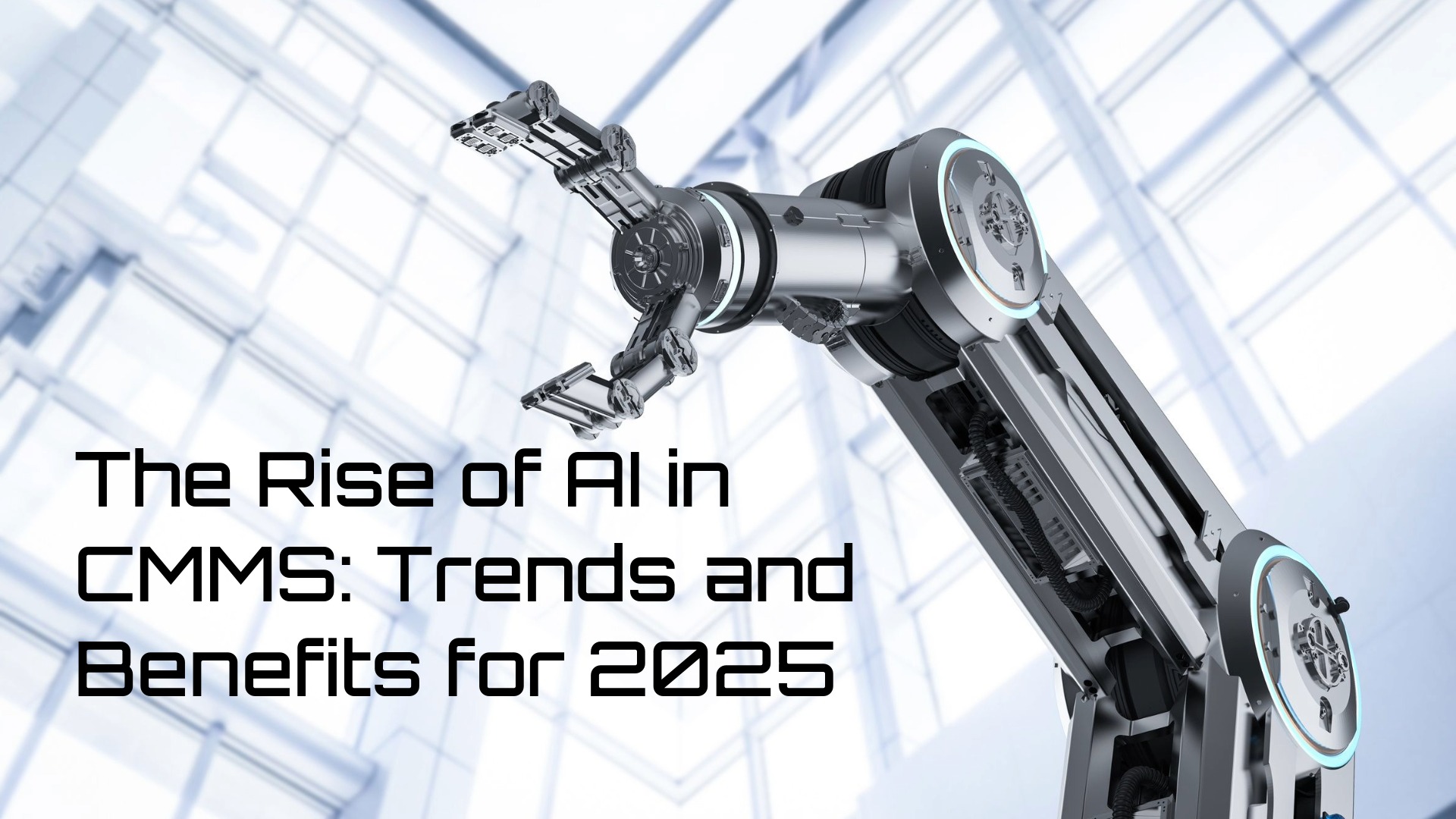The Rise of AI in CMMS: Trends and Benefits for 2025
Maintenance managers and engineers in industries like manufacturing, healthcare, and facilities management are turning to advanced technology to stay ahead of equipment failures and optimize operations. The integration of Artificial Intelligence (AI) in Computerized Maintenance Management Systems (CMMS) is a game-changer, enabling predictive maintenance, data-driven decisions, and improved operational efficiency. As we head into 2025, AI trends in CMMS promise to reduce downtime, boost productivity, and enhance asset reliability. This guide explores the latest AI trends, their benefits, and how tools like CMMS can transform maintenance management, drawing on recent industry insights to help you leverage these advancements for your organization.
Why AI Is Transforming CMMS in 2025
AI in CMMS uses machine learning and predictive analytics to analyze data from sensors, historical logs, and work orders, forecasting issues before they cause failures. This shift from reactive to predictive maintenance aligns with lean manufacturing principles, reducing waste and supporting sustainability goals. Industry reports indicate AI can cut unplanned downtime by up to 28% and extend asset life by months, directly impacting the bottom line. For maintenance managers, AI provides actionable insights, empowering teams to focus on high-value tasks and improving overall equipment effectiveness (OEE).
A manufacturing plant, for example, integrated AI into its CMMS to monitor compressor vibration, predicting failures and avoiding costly emergency repairs, which improved MTBF by 18 months.
Key AI Trends in CMMS for 2025
AI trends are reshaping CMMS, with innovations focusing on automation, analytics, and integration:
-
AI-Driven Predictive Maintenance: AI analyzes patterns in sensor data, like temperature or lubricant levels, to trigger work orders before failures occur, minimizing downtime.
-
Fault Pattern Recognition: Machine learning identifies subtle anomalies in failure logs, enabling root cause analysis and preventive actions.
-
Smart Scheduling and Automation: AI optimizes maintenance schedules based on asset criticality, technician availability, and workload, automating 80% of routine tasks in some cases.
-
Advanced KPI Dashboards: Real-time analytics track metrics like MTBF, MTTR, and OEE, providing confidence scoring for failure likelihood.
-
IoT and Sensor Integration: AI processes data from the Internet of Things (IoT) for condition monitoring, enhancing predictive capabilities.
-
These trends, highlighted in 2025 reports, enable facilities to achieve operational excellence by reducing energy waste and improving resource allocation.
Benefits of AI in CMMS
AI delivers tangible benefits for maintenance teams:
-
Reduced Downtime: Predictive analytics prevent failures, with studies showing 20-30% reductions in unplanned outages.
-
Cost Savings: By optimizing inventory and labor, AI cuts maintenance costs by 15-25%, minimizing overstocking and emergency repairs.
-
Improved Efficiency: Automation streamlines workflows, boosting technician productivity and OEE by up to 19%.
-
Enhanced Reliability: Condition monitoring extends asset life, supporting sustainability by reducing waste and resource use.
-
Data-Driven Decisions: Analytics provide insights for root cause analysis, improving quality control and customer satisfaction.
A logistics company automated preventive maintenance (PMs) with AI, reducing scheduling errors by half and improving uptime.
AI in CMMS for Manufacturing
In manufacturing, AI enhances mass production by monitoring machines for wear and tear. Predictive maintenance analyzes vibration data to schedule lubrication, improving OEE and reducing scrap. A plant used AI to predict pump failures, extending MTBF and aligning with six sigma standards for quality.
AI in CMMS for Healthcare
Healthcare prioritizes safety and regulatory compliance, where AI monitors medical equipment like ventilators for anomalies. Condition monitoring ensures calibration, reducing MTTR and preventing health risks. A hospital integrated AI for HVAC, cutting energy costs by 15% while maintaining uptime.
AI in CMMS for Facilities Management
Facilities management benefits from AI in optimizing diverse assets like elevators. Predictive analytics tracks performance indicators, enabling proactive repairs and resource efficiency. A university used AI to monitor lighting, reducing energy waste and enhancing maintainability.
Comparing AI Applications Across Industries
AI in CMMS adapts to industry needs:
-
Manufacturing: Focuses on OEE and mass production, using AI for high-volume predictive maintenance.
-
Healthcare: Emphasizes safety and compliance, with AI ensuring low MTTR for critical equipment.
-
Facilities Management: Balances cost and uptime, leveraging AI for resource optimization and sustainability.
Benchmarking shows manufacturing leads in IoT integration, while healthcare excels in regulatory analytics, offering cross-industry lessons for innovation.
The Role of Technology in AI-Enabled CMMS
Technology like CMMS is key to AI implementation, automating data collection from sensors and enabling predictive analytics. CMMS integrates with IoT for condition monitoring, providing real-time dashboards for performance indicators. Automation streamlines work orders, while machine learning refines predictions over time. A facility used CMMS AI to analyze downtime data, improving efficiency by 19% through targeted maintenance tasks.
How MicroMain’s CMMS Leverages AI for 2025
MicroMain’s CMMS integrates AI trends to empower maintenance managers with smart, efficient tools for industries like manufacturing, healthcare, and facilities management. It offers:
-
AI-Driven Predictive Maintenance: Analyzes sensor data for vibration or temperature patterns, triggering work orders to prevent failures and reduce downtime.
-
Predictive Analytics: Provides confidence scoring for failure likelihood, optimizing schedules and improving OEE.
-
Fault Pattern Recognition: Uses machine learning to detect anomalies in historical logs, supporting root cause analysis.
-
Work Order Automation: Smart scheduling based on asset criticality and technician availability, boosting productivity.
-
Inventory Management: AI optimizes reorder points, reducing waste and costs.
-
Mobile Accessibility: The MicroMain Global app enables on-the-go updates, enhancing communication and workflow.
-
System Integration: Connects with ERP and IoT via an open API, aligning with sustainability goals like energy reduction.
A manufacturing facility using MicroMain’s CMMS reduced unplanned downtime by 28% through AI condition monitoring, extending asset life and improving profit margins. With pricing starting at $99 per admin license and $45 per technician license for cloud-based deployment, MicroMain delivers strong ROI. Sign up for a 30-day free trial or schedule a demo at www.micromain.com to experience AI-enhanced maintenance.
Real-World Impact of AI in CMMS
AI delivers proven results. A manufacturing plant used AI for compressor monitoring, extending life by 18 months and reducing costs by 15%. A hospital improved MTTR for ventilators, ensuring safety. A facilities manager optimized HVAC, cutting energy by 15%. These case studies show AI’s role in sustainability, quality control, and operational excellence.
Overcoming Challenges in AI Adoption
Challenges like data complexity and workforce adoption can be addressed:
-
Data Centralization: Use CMMS to integrate IoT for accurate analytics.
-
Training: Provide education on AI tools to enhance skills and empowerment.
-
Start Small: Focus on key assets for quick wins.
-
Support: Leverage robust systems for implementation.
MicroMain simplifies adoption with an intuitive interface, training (online, onsite, or Austin Center), and a 30-day free support period.
Getting Started with AI in CMMS
Start by assessing needs, setting goals for downtime reduction, and adopting a CMMS with AI features. Leverage predictive analytics and condition monitoring to drive efficiency. A CMMS enables this, offering automation and insights for success.
Ready to embrace AI? Explore how MicroMain’s CMMS can transform your strategy by visiting www.micromain.com for a free trial or demo. Empower your team for 2025.







